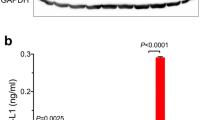Abstract
The human monoclonal antibody AE6F4 specifically reacts with human lung cancer tissues but does not with normal tissues. This monoclonal antibody recognizes a cytosolic 31 kDa antigen in the cancer cells. In a previous study, we elucidated that the 31 kDa antigen belonged to a family of proteins collectively designated as 14-3-3 proteins, which were known as protein kinase-dependent activators of tyrosine/trytophan hydroxylases, or protein kinase C inhibitor proteins. Here we report molecular cloning of the 31 kDa antigen from the human lung adenocarcinoma cell line, A549. Sequencing analysis indicates that the cloned cDNA is identical to that of previously reported human placental cytosolic phospholipase A2 (cPLA2), which is also a member of the 14-3-3 protein family. Western analysis demonstrated that a 31 kDa recombinant cPLA2 expressed in monkey COS cells was recognized by the AE6F4 monoclonal antibody. Binding of the monoclonal antibody to the recombinant cPLA2 was abolished when treated with sodium periodate, suggesting that not only are carbohydrate chains associated with the cPLA2, but they also play a crucial role in antigen recognition by the monoclonal antibody.
Similar content being viewed by others
References
Boston PF, Jackson P, Kynoch PAM and Thompson RJ (1982a) Purification, properties, and immunohistological localization of human 14-3-3 protein. J. Neurochem. 38: 1466–1474.
Boston PF, Jackson P, and Thompson RJ (1982b) Human 14-3-3 protein: Radioimmunoassay, tissue distribution, and cerebrospinal fluid levels in patients with neurological disorders. J. Neurochem. 38: 1475–1482.
Burch RM and Exelord J (1987) Dissociation of bradykinin-induced prostaglandin formation from phosphatidylinositol turnover in Swiss 3T3 fibroblast: evidence for G protein regulation of phospholipase A2. Proc. Natl. Acad. Sci. USA 84: 6374–6378.
Glisin V, Crkvenjacov R and Byus C (1974) Ribonucleic acid isolated by cesium chloride centrifugation. Biochem., 13 (12): 2633–2637.
Goldberg HJ, Viegas MM, Margolis BL, Schlessingen J and Skorecki KL (1990) The tyrosine kinase activity of the epidermal growth factor receptor is necessary for phospholipase A2 activation. Biochem. J. 127: 461–465.
Hakomori S (1989) Aberrant glycosylation in tumors and tumor-associated carbohydrate antigens. Adv. Cancer Res. 52: 257–331.
Ichimura T, Isobe T, Okuyama T, Yamauchi T and Fujisawa H (1987) Brain 14-3-3 protein is an activator protein that activates tryptophan 5-monooxygenase and tyrosine 3-monooxygenase in the presence of Ca2+, calmodulin-dependent protein kinase II. FEBS Lett. 219: 79–82.
Ichimura T, Isobe T, Okuyama T, Takahashi N, Araki K, Kuwano R and Takahashi Y (1988) Molecular cloning of cDNA encoding for brain specific 14-3-3 protein kinase-dependent activator of tyrosine and tryptophan hydroxylase. Proc. Natl. Acad. Sci. USA 85: 7084–7088.
Kawahara H, Shirahata S, Tachibana H and Murakami H (1992)In vitro immunization of human lymphocytes with human lung cancer cell line A549. Hum. Antibod. Hybridomas 3: 8–13.
Laemmli UK (1970) Cleavage of structural proteins during the assembly of the head of bacteriophage T4. Nature 283: 249–256.
Lin L-L, Lin AY and DeWitt DL (1992) Interleukin 1α induces the accumulation of cytosolic phospholipase A2 and the release of prostaglandin E2 in human fibroblasts. J. Biol. Chem. 267: 23451–23454.
Lin L-L, Wartmann M, Lin AY, Knopf JL and Davis RJ (1993) cPLA2 is phosphorylated and activated by MAP kinase. Cell 72: 269–278.
McIntyre TM, Reinhold SL, Prescott SM and Zimmerman GA. (1987) Protein kinase C activity appears to be required for the synthesis of platelet-activating factor and leucotriene B4 by human neutrophils. J. Biol. Chem. 262: 15370–15376.
Moore BW and Perez VJ (1967) Specific acidic proteins of the nervous system In: Carlson FD, (ed.) Physiological and Biochemical Aspects of Nervous Integration pp. 343–359. Prentice-Hall, Englewood Cliffs, New Jersey.
Nakamura T, Lin L-L, Kharbanda S, Knopf J and Kufe D (1992) Macrophage colony stimulating factor activates phosphatidyl chorine hydrolysis by cytoplasmic phospholipase A2. EMBO J. 11: 4917–4922.
Nielsen PJ (1991) Primary structure of a human protein kinase regulator protein. Biochim. Biophis. Acta 1088: 425–428.
Sambrook J, Fritsch EF and Maniatis T (1989) Molecular Cloning: a Laboratory Manual, 2nd ed. (Cold Spring Harvor, New York: Cold Spring Harvor Laboratory).
Sanger F, Nicklen S and Coulson AR (1977) DNA sequencing with chain-termination inhibitors. Proc. Natl. Acad. Sci. USA 74: 5463–5467.
Sharp JD, White DL, Chion XG, Goodson T, Ganboa GC., McClure D, Burgett S, Hoskin J, Skatrud PL, Kang LH, Robert EF and Kramer RM (1991) Molecular cloning and expression of human Ca2+-sensitive cytosolic phospholipase A2. J. Biol. Chem. 266: 14850–14853.
Shoji M, Kawamoto S, Sato S Kamei M, Kato M, Hashizume S, Seki K, Yasumoto K, Nagashima A, Nakahashi H, Suzuki T, Nomoto K and Murakami H (1994a) Specific reactivity of a human monoclonal antibody AE6F4 against cancer cells in tissues and sputa from lung cancer patients. Hum. Antibod. Hybridomas, in press.
Shoji M, Kawamoto S, Setoguchi, Y. Mochizuki K, Honjoh T, Kato M, Hasizume S, Nomoto K and Murakami H (1994b) The 14-3-3 protein as the antigen for lung cancer-associated human monoclonal antibody AE6F4. Hum. Antibod. Hybridomas, in press.
Takebe Y, Seiki M, Fujisawa J-I, Hoy P, Yokota K, Arai K-I, Yoshida M and Arai N (1988) SRα promotor: an efficient and versatile mammalian cDNA expression system composed of the simian virus 40 early promotor and the R-U5 segment of human T-cell leukemia virus type 1 long terminal repeat. Mol. Cell. Biol. 8: 466–472.
Toker A, Ellis CA, Sellers LA and Aitken A (1990) Protein kinase C inhibitor proteins. Eur. J. Biochem. 191: 421–429.
Ullrich A, Shine J, Chirgwin J, Pictet R, Tischer E and Rutter W (1977) Rat insulin gene: Construction of plasmids containing to coding sequences. Science 169: 1313–1319.
Zupan LA, Steffens DL, Berry CA, Landt M and Cross RW (1992) Cloning and expression of a human 14-3-3 protein mediating phospholipolysis. J. Biol. Chem. 267: 8707–8710.
Author information
Authors and Affiliations
Rights and permissions
About this article
Cite this article
Kawamoto, S., Shoji, M., Setoguchi, Y. et al. Molecular cloning of the 31 kDa cytosolic phospholipase A2, as an antigen recognized by the lung cancer-specific human monoclonal antibody, AE6F4. Cytotechnology 17, 103–108 (1995). https://doi.org/10.1007/BF00749397
Received:
Accepted:
Issue Date:
DOI: https://doi.org/10.1007/BF00749397




